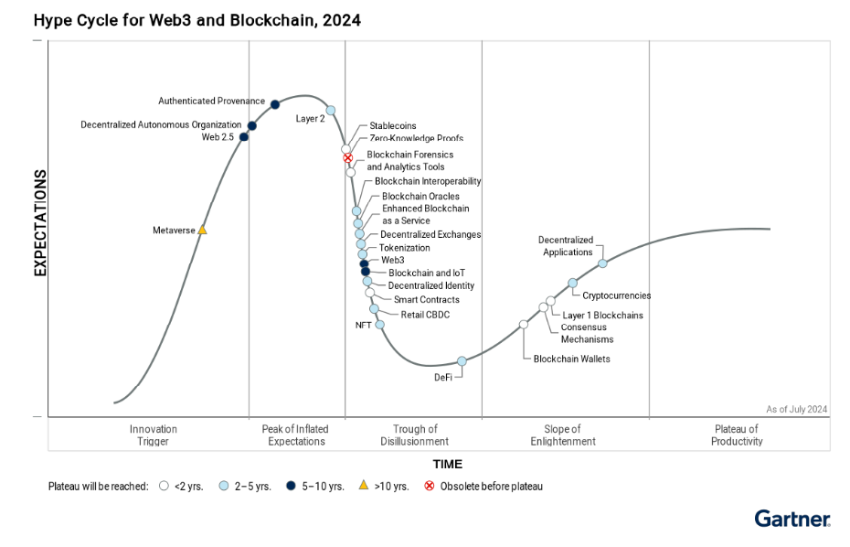In late July, Gartner published its 2024 version of the hype cycle for Blockchain and Web3. One of the most notable aspects is which technologies it believes will reach the plateau of productivity in the next two years. These include blockchain wallets, smart contracts and stablecoins.
Amongst the biggest recent advancements highlighted by Gartner are Layer 2 scaling solutions, DeFi, non-fungible tokens (NFTs) and cross-chain interoperability.
At first, one or two of the mentions on the downward curve appear out of place. While sentiment is certainly negative for NFTs and Retail CBDC, there is a fair amount of hype surrounding the tokenization of real-world assets (RWA) at the moment.
However, many in the blockchain sector (us included) tend to focus on finance. By contrast, Gartner explores tokenization across a variety of industries, mainly for business automation. On that front, the position of tokenization makes sense.
Likewise, stablecoins appear on the down curve, despite nearing all time highs in market capitalization, which should reflect adoption. Additionally, there’s a raft of new stablecoin initiatives and improving legal clarity. However, Gartner is looking at it more broadly, considering mainstream consumer adoption. Stablecoins are still associated with cryptocurrencies which have negative connotations for many, particularly following the collapses of Terra and FTX. That hasn’t changed much during the past year.
Web 3 combined with web2: web 2.5
Given Gartner’s multi industry viewpoint, one valuable recent addition is the concept of web 2.5. This involves combining web3 objects such as NFTs, tokens or smart contracts into web2 applications. For us, the most obvious application is large corporates launching NFTs and hosting web2-style NFT marketplaces.
Gartner classified Franklin Templeton’s OnChain U.S. Government Money Fund as web2.5. Other examples might include hosted wallets and centralized crypto exchanges.
While web2 is centralized, it also emphasizes front end usability. In contrast, web3 at its core is a backend innovation. Frankly, many web3 user interfaces range from bad to awful.
Meanwhile, one notable omission from the hype cycle is wholesale CBDC, perhaps because it’s not web3, although other permissioned applications were included. Retail CBDCs have a place on the curve, despite many projects eschewing the direct use of blockchain. By contrast, wholesale CBDC has experienced a renaissance and is always DLT-based. The latest BIS CBDC survey shows wholesale activity overtaking retail CBDC. This could have a major impact on adoption, as some projects look to empower blockchain applications, including web3, such as Brazil’s DREX.
Gartner also published a classification of which technologies it considers transformational – ones that will affect industry dynamics. The applications likely to go mainstream within two years include stablecoins, smart contracts, layer 1 blockchains, blockchain wallets and consensus mechanisms. Three of the transformational technologies likely to gain traction in two to five years are tokenization, cryptocurrencies and blockchain interoperability. There’s been a lot of progress and the future looks rosy, but there’s still much work ahead.
This news is republished from another source. You can check the original article here










